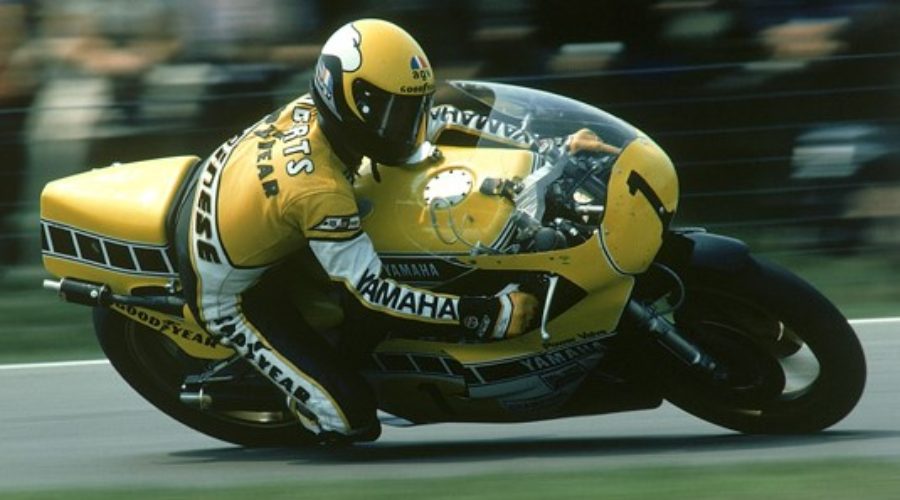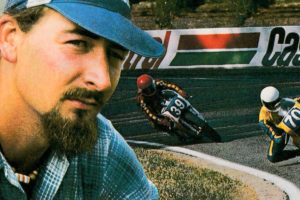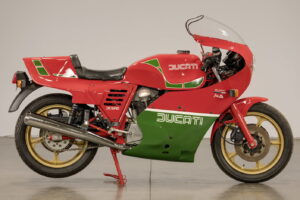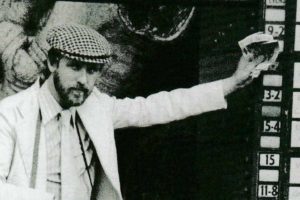Racing’s Greats: Kenny Roberts
Ten years ago a super-confident, race-smart, 26-year-old twice American Motorcyclist Association champion from a dusty part of California came to Europe and did a job most thought impossible.
His name was Kenny Roberts, and “the job” was winning the world 500 championship at his first attempt. Roberts came back in 1979, after a crash that nearly killed him, and did it again. He made it three in a row in 1980. Riders have been trying to win two in a row ever since.
The more deeply you examine the 1978 season, the more impressive Kenny Roberts’ victory becomes.

The ’78 world championship calendar included two public road circuits, which Roberts hated, and the old Nurburgring. But he made himself finish in the top three at the 14 km Spa-Francorchamps and the 23 km Nurburgring. Roberts in ’78 came with just one Yamaha 500. Factory number one Johnny Ceccotto had two better bikes. Suzuki, it might be argued, had better bikes again.
Roberts simply took Europe by storm in 1978 and put the odd nose out of joint in the process. A few of those noses needed shifting and some old ideas with them.
Kenny’s arrival in Europe helped make Grand Prix racing more professional.
Today he runs a team which is trying to make the sport still more professional and technologically advanced. The statistics of Kenny Roberts’ career don’t tell all the story. Roberts won three world titles and 22 Grands Prix in the premier class, and two 250 GPs. His 500 Grand Prix tally is the same as those of Geoff Duke and John Surtees.
Kenny won many of his races, and I would argue two of his world championships, when he did not have the most stable or the fastest motorcycle.
Roberts also went within two points of winning a fourth world crown in his swansong year (1983), with a bike and tyres his team reckoned were inferior. His career in the 1980s was often dogged by underdeveloped motorcycles and/or tyres.

Rivals thought Roberts had “magic” Goodyear tyres when he arrived in 1978. In truth, the Ohio-based company had never produced a tyre for a racing 500 before ’78. And Kenny was the only guy around to test them, with his one 500.
Often Roberts would test all the new tyres and still race on his regular rear tyre compound. But he didn’t let his rivals know his supposed advantage was also a handicap.
Roberts was smart. He was also, although it wasn’t widely reported, a master of racer psychology. Australian mechanic Dave Cullen, who was in the same team as Kenny in 1983 (working for Eddie Lawson), observed Roberts psyching from close range.
“It was quite an experience to see the way Kenny worked psychologically on his opponent’s minds – the way he talked to other riders. He was so confident, he had all the opposition wondering how they could beat him,” Cullen said. “Kenny could destroy his opposition before he raced them, if he talked to them. And he had the ability to back up what he said. The only rider Kenny couldn’t work on was Freddie Spencer, because Freddie didn’t talk to anybody!” he said.
Europeans who took the trouble to get to know Roberts soon found he could be as outrageous off the track as he was devastating on it. His “mooning” of everyone from factory executives to mates is almost legendary. Photographer Don Morley has a signed print in his library from Kenny, which says something like: “You’re a great photographer, but you’ll never be as great a crepitator (farter) as me.”
Kenny could be at once a prangster and kid. After one lmola 200 he put a rental car sideways, then steered away from the slide instead of into it, to see what would happen. The car, loaded with fellow riders, rolled.
Roberts could ride around the Daytona tri-oval flat out on his works Yamaha 750, and still have time to both recognise and wave to friends driving through the exit tunnel in a convertible. In short, Roberts could ride. He was the first on the Grand Prix stage to take dirttrack technique and marry it, using the characteristics of modern slick tyres, to road racing.

Kel Carruthers taught Kenny early that the place to make time on the race track was on fast corners. That’s what Kenny meant by “ride slow on the slow corners and fast on the fast ones.”
The technique Roberts developed was take it slow into corners and come out hard and fast. He’d push the front wheel on slow corners, where he could keep the bike upright with his knee if the tyre slipped. But on fast corners a front-end slide might be irretrievable – you’re on the ground before you can do anything. So Roberts used wheelspin to push the back wheel out of line. Kenny’s dirt-track background made it relatively easy for him to feel the limit of rear adhesion.
Kenny Roberts was arguably the most against the odds world 500 champion of all time. His one piece of luck was to hit his stride just as the Japanese factories started putting big money into US road racing.
Kenny’s parents were a working class couple, Buster and Alice Roberts, of Modesto, California. They bred them tough in Modesto. Alice had, as a 15 year old, wound a brother’s 1200 Harley up to nearly 160 km/h and taken both hands off the bars to scare a male pillion.
Kenny, Alice’s second son, was born prematurely on December 31, 1951. Alice had been injured in a car accident a week earlier. Kenny’s parents reckoned him lucky to see his fourth birthday. He had pneumonia three times in his first three years.
Roberts began racing illegally at 14 on a second-hand Tohatsu his mother scrimped to buy. His next bike was a Hodaka 90, and he started winning.

Three men played key roles in Roberts’ next six years of racing. Bud Aksland was the first. Bud began supplying parts for pint-sized Kenny’s Hodaka. Soon he was repairing and maintaining it at this motorcycle dealership. Bud progressed from there to sponsoring Kenny on Hodakas and Suzukis, and wrenching for Kenny when he went on the road to national events.
Former fighter pilot and later Pan-Am cargo skipper Jim Doyle was the next key player. Doyle provided a level of sponsorship which was beyond Bud Aksland’s resources.
Each week in 1970 Doyle took Kenny south to Ascot Park (near Los Angeles) to race. Doyle also tracked down trade sponsors, took Kenny road racing, promoted him, took him across the country to Daytona in 1970, and negotiated his first contract with Yamaha.
The first Yamaha deal was enough to put Kenny Roberts and Bud Aksland on the road with a couple of bikes and a van in 1971, Kenny’s Junior year. They followed the same exhausting trail as the Experts, with Roberts riding the same variety of tracks – mile, half mile, short track, TT (a short-track event with jumps) and road races.
Kenny Roberts would later become the first rider to win at all these disciplines in AMA National competition.
Roberts in 1971 was soon winning Junior races. He won at his third start in an AMA Junior (250 cm3) road race and a few months later led former world 250 champion Kel Carruthers for much of a combined Junior/Expert 250 National at Kent, Washington.
At the end of the 1971 season Kenny was the nation’s leading Junior rider. Doyle had talked Yamaha into taking a risk on Roberts the Novice. Now it had the nation’s best Junior on its books.
Yamaha in 1972 hired the third of the key Roberts players, Kel Carruthers, as a road racer. The company gave Kel and Kenny 350s to race against the opposition 750s in the National road races.
Roberts began 1972, his first season in the AMA Expert ranks, in top form. After two races he’d scored his first victory in the Expert ranks and led the AMA National Championship. Kenny also led the third race, the Daytona 200 mile road race, until he suffered a flat tyre. The remainder of Kenny’s dirt-track season fell apart. Kenny slipped to fourth in the final championship positions. But the failure in ’72 taught Roberts and Yamaha they could win the AMA title if they were properly organised.
Roberts in 1973 became the youngest rider ever to win the AMA National Championship. His final points tally almost equalled the combined tallies of second-placed Gary Scott and thirdplaced Gary Nixon. Roberts won the AMA National Championship again in 1974, from Gary Scott.
In June 1974 Carruthers took Kenny to the Dutch Grand Prix at Assen, to sample world championship road racing. Roberts qualified fastest for the 250 GP and fell off while duelling with that year’s world champion Walter Villa (H-D/Aermacchi). Kenny-remounted to finish third, after setting the fastest lap. It was a performance a few pundits forgot when they made predictions for 1978.
Roberts started 1975 with four straight victories in the AMA Championship. He finally won a race at Daytona (the 250 cc), but suffered his fifth straight disappointment in the 200 miler.
As the season went on Yamaha’s lack of a truly suitable dirt-track engine told.
Roberts even tried using the TZ750 road-race engine. He made history by winning the mile dirt-track at Indianapolis on this creation, then said it should be banned for the good of the sport. Roberts knew as well as anyone that American racing needed Harleys.

Roberts finished second in the ’75 AMA championship to Gary Scott. In 1976 he was third, behind Jay Springsteen and Scott. In 1977 he slipped to fourth. Yamaha even found another American hot-shoe road-racer in Steve Baker.
Baker beat Roberts in some National road races in ’76 and at Daytona in ’77. In what might have ultimately been good luck for Kenny, Yamaha then took Baker into the 1977 world 500 championship to try to unseat Suzuki’s new world champion Barry Sheene.
Roberts, meantime, was running out of options on where and what to race for Yamaha. In 1977 the number of AMA road race Nationals increased to six, and Roberts won all except Daytona on his OW31 Yamaha 750. His only other road races were the big-paying pre and end-of-season internationals in Europe.
Kenny Roberts this year told me he was forced to race in Europe in 1978.
“There had been talk on and off of me going to Europe, but nothing serious. Then it became clear in 1977 that the Yamaha dirt-tracker wasn’t competitive.
“There was nothing else for me to do except go to Europe. If I’d just stayed in America and road raced I would have only run about seven events a year. That wouldn’t have bettered my career. So it was decided, well, let’s go and try to win the world championship,” he said.
Yamaha America backed the team and gave Carruthers the chequebook. Roberts began the season by at last winning the Daytona 200. Next stop was the opening round of the world championships in Venezuela. Kenny won the 250 race but stopped on the second lap of the 500 GP with a broken engine.

The second GP in Spain saw Roberts qualify fastest for both the 250 and 500 classes and finish second in both classes. Gregg Hansford won the 250 race and American Pat Hennen (Suzuki) the 500, after Roberts suffered sticking throttle slides.
Roberts then won the next three 500 championship rounds, in Austria, France and Italy, to take a lead he was never to lose in the championship. So what had happened to the opposition? The final points table of the 1978 world 500 championship suggests Barry Sheene was Roberts’ big threat. In the long term he was, but early in the season Roberts’ principal opponent was another Californian, Pat Hennen.
Hennen knew how Roberts operated. Pat predicted Kenny would arrive and blitz everybody, then begin to dislike life on the road and some of the circuits in the second half of the season. He even predicted (correctly) the winning championship points tally of 110 from 11 races.
Five rounds into the season the Hennen theory was holding. Roberts led the title and Hennen was second, ahead of Sheene. Roberts’ pointscoring did fall away in the second half of the season. But Pat didn’t benefit. He was in hospital after crashing at the Isle of Man TT.

So Roberts’ opposition came down to Sheene, whom he effectively psyched out in the first half of the season; Ceccotto, who proved he was not serious to Roberts in Venezuela by retiring with a chattering front tyre; Wil Hartog, who only received works bikes after Hennen was hurt; and Takazumi Katayama, who only finished one race in the first half of the season.
Roberts’ winning 500 streak ended in Holland. He was second to the all-toorarely motivated Ceccotto. The following week Kenny overcame his horror at the high-speed Spa-Francorchamps road circuit to finish second behind Hartog in the rain.
Kenny’s 250 campaign ended at the same meeting. He’d won in the rain at Assen, but his machine seized on the first lap at Spa.
The 500 campaign nearly came unstuck in the next GP, in Sweden. Kenny was busy testing tyres during practice. It was a bit like Eddie Lawson’s incident this year in Yugoslavia. Kenny ran off the track and elected to low-side the bike rather than run into a fence. But the front wheel turned sideways and highsided him. Roberts was knocked out for 20 minutes. His seventh placed the next day let Sheene back into title contention.
Events at the next GP, on the public roads in Finland, also had a familiar ring for defending champion Barry Sheene. Sheene’s Suzuki stopped with a broken main bearing. Roberts also stopped with ignition trouble, but Sheene’s big chance of a third 500 title had gone.
The British Grand Prix at Silverstone saw Roberts again stretch the points lead, after an extraordinary race. The race started in the dry, then the heavens opened. Carruthers and his crew changed Roberts’ wheel in about one third the time it took Sheene’s, and so Kenny won the race. It was the first motorcycle GP ever where the winner changed wheels mid-race.
The final round was at Nurburgring. Roberts needed to finish no worse than fourth if Sheene won. But Kenny did better, finishing third, ahead of Sheene. Kenny was King.

Roberts missed the world F750 championship by five points. He won four rounds, compared with title winner Ceccotto’s three. Roberts too often set fastest lap and had few or no points to show for it at the end of the day.
On February 14, 1979, Kenny Roberts, world 500 champion, crashed at Yamaha’s Iwata test track and went back-first into an armco barrier at nearly 160 km/h. He fractured several vertebrae and damaged his spleen so badly it was removed. His condition was critical. The first question was more whether he’d live than how many races he’d miss. Kenny missed two races – Daytona and the opening round of the world championship in Venezuela.
On April 29, 74 days after the crash, Kenny returned to racing in round two of the championship and won the Austrian GP. He was second to Wil Hartog in Germany a week later, then won the next three rounds to annex the world championship series lead from Virginio Ferrari.
Roberts was back, like he’d never been away.
Kenny won once more that season, beating Sheene in a thrilling race at Silverstone. That result put the title beyond doubt. Ferrari had been the number one threat, until a series of mechanical stuff-ups in the second half of the season. And Hartog would have been a real threat, if he’d learned you didn’t have to win every race. The big Dutchman crashed out of the lead in four races.

Kenny Roberts spent much of late ’79 and early 1980 trying to get a new deal for world championship riders. The World Series movement ultimately failed, but it did win a doubling in prizemoney and improvements in safety.
Roberts took his third world championship in 1980. Yamaha’s pistonported in-line four struggled this time against the ever-faster Suzuki disc-valve square fours. Roberts won the first three Grands Prix of the season. Jack Middelburg won on home ground at Assen on a privately entered Yamaha, and Suzukis won the remaining four races.
Kenny again had to clinch the title at Nurburgring. And clinch it he did from Randy Mamola.
Yamaha built its own square four in 1981. It put Roberts back in the horsepower stakes with Suzuki, but the rotary disc valve induction system gave power characteristics which didn’t suit the riding style he’d developed. Suzuki’s square four was, meantime, reaching the peak of its development.

Marco Lucchinelli won the world championship in 1981, from fellow Suzuki rider Mamola. Roberts and new Yamaha teammate Sheene were third and fourth. Roberts won two of the first three Grands Prix at Hockenheim and Monza. After that it was lean pickings.
Eighty-two produced more disappointments. Yamaha was busy with another development year, this time giving Roberts a complicated rotary disc valve V-four. Goodyear had withdrawn from the tyre race, so Roberts joined Mamola on Dunlops. Franco Uncini dominated the title, using a Michelinshod Suzuki.
Kenny won the opening round in Argentina on the square four, and rode what he thought was the best race of his career to win on the V-four at Jarama. Kenny crashed out of the championship on the first corner of round nine at Silverstone, breaking a finger. He did not race again until Daytona, in March ’83.
Kenny was candid when I suggested he’d won at least two of his titles without the luxury of the best bike.
“I wouldn’t say without the best bike. It’s pretty hard to win the world championship without a good bike. I just had the bike I had – there was no way I could make it any better,” Roberts said. “I think it had some good points – top speed wasn’t really one of those points. Sometimes when we did have top speed we couldn’t get the acceleration. But the rotary-valve Suzuki seemed a bit better all round. But as for an actual better bike, I don’t really think that their bike was that much better than mine.
“The crankcase reed valves have been the biggest area of improvement in the bikes in the last ten years, in terms of being able to transfer rideable power to the race track.” he said.
Roberts said his most satisfying race ever was the 1982 Spanish GP at Jarama, where on the V-four he beat Barry Sheene’s Yamaha square four by eight seconds.

“It was the most satisfying because I really didn’t reckon the bike should be in the top five! The tyres went off fairly quickly, so I was just running kerb to kerb, bouncing off the kerbs, to stay in the lead. Mentally and physically I had to ride the thing 100 per cent to keep it on the race track,” Roberts said.
”I remember that race because I had to do everything textbook. And I had to do it for the whole race, because Sheene was wanting to beat me. I couldn’t slack off because when you’re using the kerbs, one mistake and you’re over the kerb and onto the grass.”
Roberts made his last bid for the world 500 title in 1983, using a revised rotary valve V-four Yamaha and Dunlop tyres. Principal opposition was Freddie Spencer on the piston-reed valve Honda V-three, on Michelins. Spencer’s bike didn’t have as much horsepower as Roberts’, but it was quicker away from the push starts and about as quick in lap times.

There were 12 races in the season. Spencer and Roberts each won six. Each had one DNF – Roberts ran out of fuel at Monza and Spencer broke a crankshaft at Salzburgring. The difference in the end could have been Sweden, where one point of view has it that Spencer ran Roberts off the track just before the finish.
Roberts won the final race at lmola, but Spencer’s second place was good enough to give Spencer the title by two points.
Kenny rode Daytona and Laguna Seca in 1984, and won both. It was his third victory in the Florida 200 miler and his sixth at Monterey. Kenny rode at Laguna Seca again in 1985 and finished fifth, and raced in the Suzuka Eight-Hour in 1986.
Kenny Roberts’ career post 500 championship racing has seen him for the last three years run a 500 Grand Prix team. Kevin Magee, Wayne Rainey, John Kocinski, Mike Sinclair and Bud Aksland ride or work for Team Roberts. All regard Roberts as one of the most analytical thinkers in the business.

But what was Kenny like to work for? Kel Carruthers worked with Roberts for 11 years. During that time Kenny was never happy that the bike would win next week, he always looked further ahead.
“Kenny was probably the worst person in the world to work with on a motorcycle, because he kept wanting to change damn things!” Kel told me a year after Roberts retired from Grand Prix racing.
“Kenny was really good when you’d changed something, because he’d try it and come back in and say whether it was better. But then he’d say we should change this, that and something else. In other words, Kenny was never happy. He would drive you crazy, because he would say it was perfect, then want things changed,” Kel said.
Nobby Clark – a mechanic for three of the all-time greats in Hailwood, Agostini and Roberts – reckoned Kenny was as good as any psychologically and technically. Clark said Kenny was similar to Agostini, in that liking or not liking a circuit didn’t affect the way he rode.
Clark was highly complimentary of Roberts’ ability to provide technical information for his crew. Even in Kenny’s first Grand Prix season, the veteran mechanic said he was as good as Agostini and could develop into someone as good as the best he’d ever worked for – Swiss Luigi Taveri.
By Don Cox. Two Wheels, October 1988.

Circus Life is Don’s account of the exploits of a bunch of young Australian motorcycle racers who followed the GP circuit as privateers through Europe in the 1950s. It’s beautifully written, forensically researched and accompanied by some amazing photographs. Don discusses Circus Life with Jay Leno on Jay Leno’s Garage here, and you can order a copy of Circus Life here.





